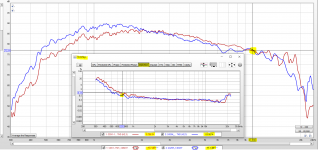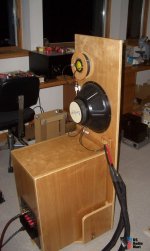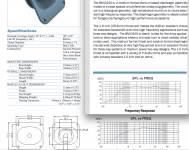What is limiting 1" compression drivers from playing <1kHz at "low" volume
Hi all,
I have a question over how low compression drivers can play.
I am looking at running a 1" CD to sub 1000Hz (lets assume 650Hz for ease of maths) on a horn with a cutoff of 500Hz.
For a driver such as the Faital HF108, it is listed as having a crossover at minimum 1.3kHz, with a power handing of 60w AES. The response plot also shows from 1.3 kHz to 650Hz as a ~3dB drop in mean efficiency (with some ripples happening that low)
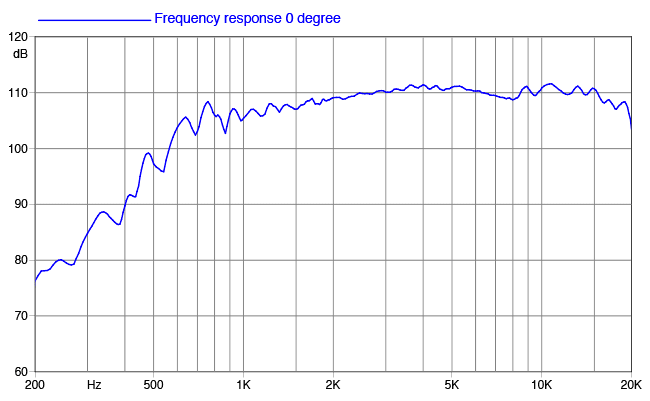
FaitalPRO | HF Drivers | HF108 (8Ω)
Assuming that this is excursion limited at this power, if I were to drop to 650Hz (and being happy with the ripple in the horn due to cutoff proximity), for the octave drop it would be able to take 1/4 of the power = 15W. Assuming that I then EQ the +3dB in at the 650Hz point, that halves again to 7.5W maximum power.
Because of other limiting components in the system, I can't see the need to exceed 5W (my eardrums included), so would this technically work?
Or, is there something else I am missing? How would it even sound that low?
Plus! Are some 1 inch drivers better suited to this type of (ab)use than others?
Many thanks in advance,
Hi all,
I have a question over how low compression drivers can play.
I am looking at running a 1" CD to sub 1000Hz (lets assume 650Hz for ease of maths) on a horn with a cutoff of 500Hz.
For a driver such as the Faital HF108, it is listed as having a crossover at minimum 1.3kHz, with a power handing of 60w AES. The response plot also shows from 1.3 kHz to 650Hz as a ~3dB drop in mean efficiency (with some ripples happening that low)

FaitalPRO | HF Drivers | HF108 (8Ω)
Assuming that this is excursion limited at this power, if I were to drop to 650Hz (and being happy with the ripple in the horn due to cutoff proximity), for the octave drop it would be able to take 1/4 of the power = 15W. Assuming that I then EQ the +3dB in at the 650Hz point, that halves again to 7.5W maximum power.
Because of other limiting components in the system, I can't see the need to exceed 5W (my eardrums included), so would this technically work?
Or, is there something else I am missing? How would it even sound that low?
Plus! Are some 1 inch drivers better suited to this type of (ab)use than others?
Many thanks in advance,
Also, how much benefit would a steeper XO slope help?
Most "recommended crossovers" are specified at 12db/oct. However, if it were to run at 18 or 24db/oct then this would massively decrease the supplied energy:
1. First order (-6dB /octave) reduces power to 1/4 per octave
2. Second order (-12dB /octave) reduces power to 1/16 per octave
3. Third order (-18dB /octave) reduces power to 1/64 per octave 4x less excursion than second order = can run an octave lower?
4. Fourth order (-24dB / octave) reduces power to 1/256 per octave
Most "recommended crossovers" are specified at 12db/oct. However, if it were to run at 18 or 24db/oct then this would massively decrease the supplied energy:
1. First order (-6dB /octave) reduces power to 1/4 per octave
2. Second order (-12dB /octave) reduces power to 1/16 per octave
3. Third order (-18dB /octave) reduces power to 1/64 per octave 4x less excursion than second order = can run an octave lower?
4. Fourth order (-24dB / octave) reduces power to 1/256 per octave
Zerokelvin99, it really depends on a few things. The driver's Fs is pretty close to where you are suggesting to cross.
Looking at an old spec sheet for an Altec Lansing 902-8B, that driver was rated to 15 watts pink noise from 500 hz all the way to 20 khz, bolted to the 511B horn. Now, the distance from the diaphragm to the phase plug as well as the area of the diaprhagm, the phase plug slot area, and even the loading of the horn has to be considered as well.
Looking at an old spec sheet for an Altec Lansing 902-8B, that driver was rated to 15 watts pink noise from 500 hz all the way to 20 khz, bolted to the 511B horn. Now, the distance from the diaphragm to the phase plug as well as the area of the diaprhagm, the phase plug slot area, and even the loading of the horn has to be considered as well.
The graph you posted is at 1w power levels, with a max power of 60w.
You could copy the response with FPgraph tracer and load it into REW. Shift the response up to what it should be at 60w then add a 12dB highpass at the recommended frequency in the EQ section on REW. This will show you what Faital pro think the maximum output should be at 650Hz.
Cheers,
Rob.
I've never run my CD's that low but I reckon for 'low volumes (in home not PA?) you should get away with it. I can post a raw response of my BMS 1" cd's with distortion at 100dB / 1 metre if that helps.
Rob.
You could copy the response with FPgraph tracer and load it into REW. Shift the response up to what it should be at 60w then add a 12dB highpass at the recommended frequency in the EQ section on REW. This will show you what Faital pro think the maximum output should be at 650Hz.
Cheers,
Rob.
I've never run my CD's that low but I reckon for 'low volumes (in home not PA?) you should get away with it. I can post a raw response of my BMS 1" cd's with distortion at 100dB / 1 metre if that helps.
Rob.
Good question.
You're going to go active with dsp?
The excursion is physically limited, so I always look sceptical at the amplitude response below resonance. Some cd's also have steep rising THD at these low frequencies.
Here's a good test of the driver you might want to have a look at, if you didn't already:
Test Bench - Faital Pro’s HF108/HF108R compression drivers coupled with LTH102 60deg x 50deg horn | audioXpress
There's no sign of troubling distortion around and below resonance, so that's looking good.
In the waterfall diagram you can see the resonance around 700 Hz having a big impact on the falling edge. How bad this is for you, only you can tell. Maybe with some tweaks with the dsp you can tame it a bit so it seems trouble free.
Another thing is the horn you're going to use with it. If it's smaller than the one used in the measurements, then you might end up with some more dB's of correction.
Whatever you do, the slope is going to be really steep below the adjustments, and you can look at it another way: attenuate the range from around 1K to 20 KHz and you're left with a -6dB 24dB/Octave crossover point of roughly 600Hz.
The bigger the diaphragm, usually the easier to drive low.
There's, coincidently, another thread where someon ponders how much excursion one needs for a given cd, horn and spl:
https://www.diyaudio.com/forums/mul...excursion-compression-driver.html#post6474114
I have no comment on that.
Goodluck!
You're going to go active with dsp?
The excursion is physically limited, so I always look sceptical at the amplitude response below resonance. Some cd's also have steep rising THD at these low frequencies.
Here's a good test of the driver you might want to have a look at, if you didn't already:
Test Bench - Faital Pro’s HF108/HF108R compression drivers coupled with LTH102 60deg x 50deg horn | audioXpress
There's no sign of troubling distortion around and below resonance, so that's looking good.
In the waterfall diagram you can see the resonance around 700 Hz having a big impact on the falling edge. How bad this is for you, only you can tell. Maybe with some tweaks with the dsp you can tame it a bit so it seems trouble free.
Another thing is the horn you're going to use with it. If it's smaller than the one used in the measurements, then you might end up with some more dB's of correction.
Whatever you do, the slope is going to be really steep below the adjustments, and you can look at it another way: attenuate the range from around 1K to 20 KHz and you're left with a -6dB 24dB/Octave crossover point of roughly 600Hz.
The bigger the diaphragm, usually the easier to drive low.
There's, coincidently, another thread where someon ponders how much excursion one needs for a given cd, horn and spl:
https://www.diyaudio.com/forums/mul...excursion-compression-driver.html#post6474114
I have no comment on that.
Goodluck!
My answer is "Distortion." Run some sweeps or even pure tones at your normal listening levels and keep an ear out for distortion. It's usually easy to hear as a doubling or tripling of the sine wave. It goes away when you get into the driver's comfort zone. At fraction of a watt in home use, you can usually cross low without damage. Just listen for that distortion in the frequencies you want to push.
Zerokelvin99, it really depends on a few things. The driver's Fs is pretty close to where you are suggesting to cross.
So, how about if I were to pick a driver with an Fs ~560Hz? For example, the HF103? Looking at the impedance plots this is the lowest of the Faitals I can find. It's also helpfully a cheaper driver (although, it suffers a little at the top end)
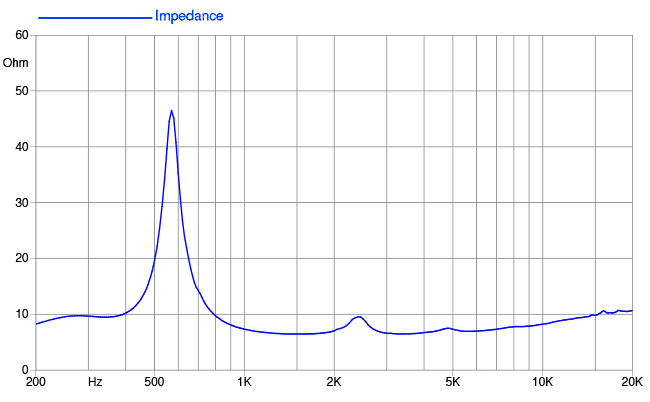
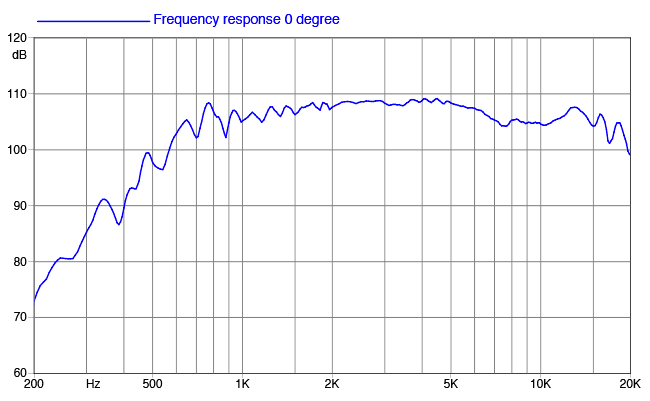
You could copy the response with FPgraph tracer and load it into REW. Shift the response up to what it should be at 60w then add a 12dB highpass at the recommended frequency in the EQ section on REW. This will show you what Faital pro think the maximum output should be at 650Hz.
Hi Rob,
Thanks - that's a great idea for REW and "simming" what it would look like. I'll give it a go tomorrow and see where the SPL ends up. And yes - this is for home use, rather than PA! I'm not trying to pop diaphragms here! 😀
Thanks for the offer of the BMS plot - would this be the same as the ones available on their site?[/B]
I think the answer to you question is "nothing!"
Check out the Summa/NS15 by GedLee (a prolific contributor here) which is a very successful design that crosses a B&C DE250 at something like 800-900hz.
Excellent lead - thank you. This is the region I was hoping to end up in..
Good question.
You're going to go active with dsp?
Yes - I have a 'spare' miniDSP which I hope to use
The excursion is physically limited, so I always look sceptical at the amplitude response below resonance. Some cd's also have steep rising THD at these low frequencies.
Here's a good test of the driver you might want to have a look at, if you didn't already:
Test Bench - Faital Pro’s HF108/HF108R compression drivers coupled with LTH102 60deg x 50deg horn | audioXpress
There's no sign of troubling distortion around and below resonance, so that's looking good.
In the waterfall diagram you can see the resonance around 700 Hz having a big impact on the falling edge. How bad this is for you, only you can tell. Maybe with some tweaks with the dsp you can tame it a bit so it seems trouble free.
Great article. I guess a notch this close to an XO would effectively raise the point, meaning a dip in total response. Overall, would best to raise above this to 800Hz+ if it was audible.
Another thing is the horn you're going to use with it. If it's smaller than the one used in the measurements, then you might end up with some more dB's of correction.
Whatever you do, the slope is going to be really steep below the adjustments, and you can look at it another way: attenuate the range from around 1K to 20 KHz and you're left with a -6dB 24dB/Octave crossover point of roughly 600Hz.
True! Again, crossing to the direct radiating element below, this would be a sharp change in directivity too. I do not know how much of a problem this would be in the real world however
The bigger the diaphragm, usually the easier to drive low.
There's, coincidently, another thread where someon ponders how much excursion one needs for a given cd, horn and spl:
Alas, I feel a 1.4" would be better suited to the job, but I am attempting to keep the sweet top end of 1"s and costs down for once
https://www.diyaudio.com/forums/mul...excursion-compression-driver.html#post6474114
I have no comment on that.
Goodluck!
My answer is "Distortion." Run some sweeps or even pure tones at your normal listening levels and keep an ear out for distortion. It's usually easy to hear as a doubling or tripling of the sine wave. It goes away when you get into the driver's comfort zone. At fraction of a watt in home use, you can usually cross low without damage. Just listen for that distortion in the frequencies you want to push.
Thanks Pano, this is what I guess it comes down to. I feel this will follow the usual route of me playing with XOs and squinting at speakers...
Here's a comparison of a Celestion CDX1-1747 vs a JBL 2425H ( both were measured on the same 18Sound XT1464 horn > adapted using an Eminence 1" to 1.4" adapter ).
- Notice how the horn and acoustic environment "imprints" the same ripples onto the two responses.

This large horn can support some pretty low crossover points.
The JBL has more lower midrange output due to its lower Fs ( around 600hz when viewed on a 1" plane-wave tube ).
🙂
- Notice how the horn and acoustic environment "imprints" the same ripples onto the two responses.
This large horn can support some pretty low crossover points.
The JBL has more lower midrange output due to its lower Fs ( around 600hz when viewed on a 1" plane-wave tube ).
🙂
Attachments
Hi Rob,
Thanks for the offer of the BMS plot - would this be the same as the ones available on their site?
It's a measurement of my speakers, but I've just checked the BMS website and their distortion plots are similar to mine so if you've seen those then mine won't be of much more help.
I noticed BMS have recommended an 800Hz xo for my driver (4550) if that's any help.
Cheers,
Rob.
Okay, with the magic of FPgraph and REW I have the maximum expected SPL at each frequency, assuming 60W AES (+17.8dB) with a 12db/oct @ 1300Hz:

So, at the 650Hz mark there's 112dB it "can output" (horn permitting).
If we were to scale the graph to 5W power input (+7db) and apply the same XO to 650Hz, we see the trace keeps below the 60W@1.3kHz XO below 650Hz.

Therefore, it seems that so long as I keep the power to 5W AES (10W@650Hz exceeds the 'maximum expected' line) then we are hunky-dory for excursion.
I can't see myself needing over 110dB, so good news there.
Distortion permitting

So, at the 650Hz mark there's 112dB it "can output" (horn permitting).
If we were to scale the graph to 5W power input (+7db) and apply the same XO to 650Hz, we see the trace keeps below the 60W@1.3kHz XO below 650Hz.

Therefore, it seems that so long as I keep the power to 5W AES (10W@650Hz exceeds the 'maximum expected' line) then we are hunky-dory for excursion.
I can't see myself needing over 110dB, so good news there.
Distortion permitting

Another question - if I may..
How is it that a horn as short as the PH-170 (length 56mm) can exist with a cut off of only 800hz? For that matter, what on earth is the directivity pattern of elliptical horns or how do they behave? Google turns a blank it seems!
http://www.paudiothailand.com/uploads/pdf/products/PH-170.pdf
How is it that a horn as short as the PH-170 (length 56mm) can exist with a cut off of only 800hz? For that matter, what on earth is the directivity pattern of elliptical horns or how do they behave? Google turns a blank it seems!
http://www.paudiothailand.com/uploads/pdf/products/PH-170.pdf
If you're willing to gamble $300 on this project, here is what I would do:
1) The first thing you have to realize, is that prosound speakers have a really low QES, a high FS and tiny enclosures. So if you wanted to extend the F3, you'd want to 3D print a different back chamber. For instance, my Celestion CDX1-1425 compression driver has a back chamber that's about 20X smaller than the back chamber on my SB26ADC tweeters.
Taken to the extreme, Bastanis removes the chamber entirely.
2) The next option, if you're really brave, would be to raise the MMS of the compression driver. This would lower the FS, raise the QTS, and lower the efficiency. But if the output is limited by displacement (and it probably is) your maximum output would be unchanged. IE, it might take more power to reach the limits after you raise the MMS, but the maximum output would likely be the same. This is the exact same concept that you see with car audio subs, where they need a ridiculously tiny box and their efficiency is terrible and the cone weighs 10 pounds, but the maximum output is very high, if you have enough amp power to get there.
1) The first thing you have to realize, is that prosound speakers have a really low QES, a high FS and tiny enclosures. So if you wanted to extend the F3, you'd want to 3D print a different back chamber. For instance, my Celestion CDX1-1425 compression driver has a back chamber that's about 20X smaller than the back chamber on my SB26ADC tweeters.
Taken to the extreme, Bastanis removes the chamber entirely.
2) The next option, if you're really brave, would be to raise the MMS of the compression driver. This would lower the FS, raise the QTS, and lower the efficiency. But if the output is limited by displacement (and it probably is) your maximum output would be unchanged. IE, it might take more power to reach the limits after you raise the MMS, but the maximum output would likely be the same. This is the exact same concept that you see with car audio subs, where they need a ridiculously tiny box and their efficiency is terrible and the cone weighs 10 pounds, but the maximum output is very high, if you have enough amp power to get there.
Attachments
Last edited:
An elliptical mouth is not indicative of a directivity pattern, the behavior must be measured. An elliptical horn could be made with virtually any pattern, but a small one such as the PH-170 won't maintain pattern 90 x 65 control much below the wavelength of it's exit dimensions, below 2300 Hz it would be nearly omnidirectional.How is it that a horn as short as the PH-170 (length 56mm) can exist with a cut off of only 800hz? For that matter, what on earth is the directivity pattern of elliptical horns or how do they behave?
As to the "800Hz cut off", it is about 11 dB down (less than "half as loud") at 800 Hz than the other horn they measured the BM-D440 driver on, 95dB sensitivity from a 1" exit driver is not much better than no horn at all.
Art
Attachments
1) The 35mm/1.4" diaphragm of the CDX1-1425 does not have much displacement compared to the usual 1.75" diaphragm 1" exit drivers. The low power rating and recommended min. crossover (12dB/oct) of 2500Hz. reflect what the driver is designed for. The small compression chamber is appropriate for reactance annulling with the high Fc horns it is designed for.1) For instance, my Celestion CDX1-1425 compression driver has a back chamber that's about 20X smaller than the back chamber on my SB26ADC tweeters.
2) The next option, if you're really brave, would be to raise the MMS of the compression driver. This would lower the FS, raise the QTS, and lower the efficiency. But if the output is limited by displacement (and it probably is) your maximum output would be unchanged. This is the exact same concept that you see with car audio subs..
2)Raising the MMS (adding weight) would kill the high frequency output, and leave the tiny displacement the same. Killing the high frequency on a sub is of no consequence, and a sub driver can have 60mm (or more)Xmech/Xlim, while a HF compression driver like the CDX1-1425 has no more than .8mm Xmech/Xlim.
Art
LOL. Yes, I know the drill.I feel this will follow the usual route of me playing with XOs and squinting at speakers...
 Maybe it's the best way, really.
Maybe it's the best way, really.A few years back and "somewhere", maybe the Altec forum, someone posted a nice picture of a 1" CD on a very long horn. Maybe 4 feet long or more. He said that it played down low just fine. From my experience with big horns and also from fiddling around with HornResp, length does seem to be key.
Here's a comparison of a Celestion CDX1-1747 vs a JBL 2425H ( both were measured on the same 18Sound XT1464 horn > adapted using an Eminence 1" to 1.4" adapter ).
- Notice how the horn and acoustic environment "imprints" the same ripples onto the two responses.
This large horn can support some pretty low crossover points.
The JBL has more lower midrange output due to its lower Fs ( around 600hz when viewed on a 1" plane-wave tube ).
🙂
EarlK, I am curious about your use of the XT1464 and a 1" driver... is there merit to this? I have a plethora of CDX1-1745 and a pair of the XT1464. I had considered using either 3D printed or those Eminence adapters.
Does the XT1464 eke that much more low end out than say the B52 clones of the QSC 1" waveguide from the HPR152i? I recall you posting measurements for the QSC/1745 combo but cannot locate them ATM. Is there a large tradeoff in on-axis frequency response? Especially in the top end?
Looking at an old spec sheet for an Altec Lansing 902-8B, that driver was rated to 15 watts pink noise from 500 hz all the way to 20 khz, bolted to the 511B horn.
Note that this is a ~211 Hz flare frequency horn with a factory installed loading cap behind the diaphragm to raise tuning to get it, showing up in a measurement with a several dB 'bump' in the response/steeper roll-off.
No clue about more modern drivers other than the physics of excursion increasing 4x/octave or maintain its status quo by reducing power 4x/octave.
- Home
- Loudspeakers
- Multi-Way
- What is limiting 1" compression drivers from playing <1kHz at "low" volume

